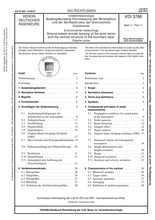Standards Worldwide
Standards Worldwide
Phone +49 30 58885700-07

Technical rule [CURRENT]
VDI 3786 Blatt 11:2015-07
Environmental meteorology - Ground-based remote sensing of the wind vector and the vertical structure of the boundary layer - Doppler sodar
- German title
- Umweltmeteorologie - Bodengebundene Fernmessung des Windvektors und der Vertikalstruktur der Grenzschicht - Dopplersodar
- Publication date
- 2015-07
- Original language
- German, English
- Pages
- 54
- Publication date
- 2015-07
- Original language
- German, English
- Pages
- 54
Product information on this site:
Quick delivery via download or delivery service
Buy securely with a credit card or pay upon receipt of invoice
All transactions are encrypted
Short description
The standard describes the active, vertical acoustic sounding of the atmosphere with Doppler sodar systems. In addition to the description of the physical fundamentals which are important for the correct application of these systems, important measurement variables are being described, which can be determined using Doppler sodar systems. The knowledge given in this standard is important for the reliable use within the fields of application like dispersion modelling (e.g. for authorization procedure), atmospheric dispersion parameters during site monitoring, site assessments for pollution control, flight safety (e.g. wind shear, displacement of vortices, advection of fog), wind energy (e.g. wind energy potential, performance characteristics, vertical wind shear), the investigation of the vertical structure of the atmospheric boundary layer and the determination of the astronomical visibility. Doppler sodar systems are, either as a replacement or supplement of measurements with meteorological masts, captive balloons and aircraft, suitable for the detection of the following atmospheric parameters: wind profiles, turbulence profiles, mixing layer height and thermal structure of the atmosphere up to several 100 m height above ground.
Content
ICS
07.060,
13.040.01
Replacement amendments
This document replaces VDI 3786 Blatt 11:1994-01 .
Also available in
Loading recommended items...
Loading recommended items...
Loading recommended items...
Loading recommended items...
